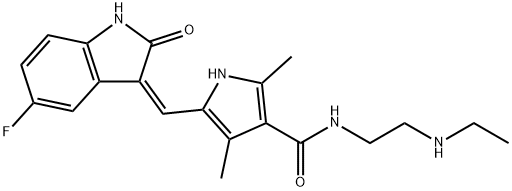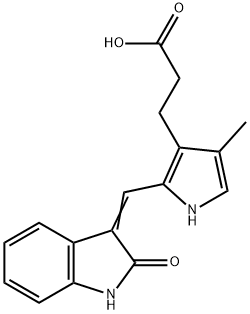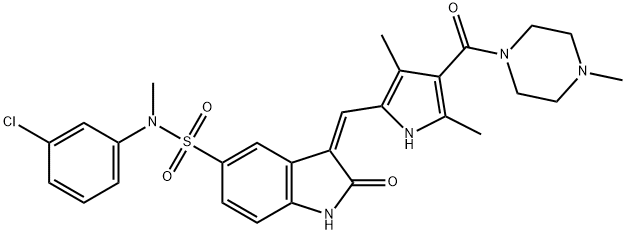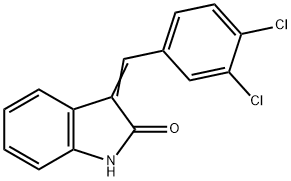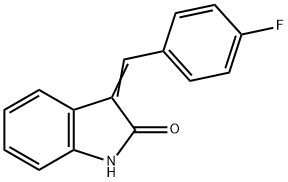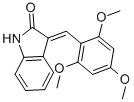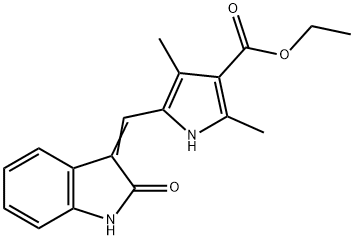5-CHLORO-3-[(3,5-DIMETHYLPYRROL-2-YL)METHYLENE]-2-INDOLINONE
Synonym(s):(3Z)-5-Chloro-3-[(3,5-dimethyl-1H-pyrrol-2-yl)methylene]-1,3-dihydro-2H-indol-2-one
- CAS NO.:1055412-47-9
- Empirical Formula: C15H13ClN2O
- Molecular Weight: 272.73
- MDL number: MFCD01868565
- SAFETY DATA SHEET (SDS)
- Update Date: 2024-11-19 15:53:33
![5-CHLORO-3-[(3,5-DIMETHYLPYRROL-2-YL)METHYLENE]-2-INDOLINONE Structural](https://img.chemicalbook.in/StructureFile/ChemBookStructure21/GIF/CB6459071.gif)
What is 5-CHLORO-3-[(3,5-DIMETHYLPYRROL-2-YL)METHYLENE]-2-INDOLINONE?
The Uses of 5-CHLORO-3-[(3,5-DIMETHYLPYRROL-2-YL)METHYLENE]-2-INDOLINONE
SU5614 is a FMS-like tyrosine kinase 3 (FLT3) inhibitor; selective inhibitor of VEGF and PDGF receptor tyrosine kinases.
Definition
ChEBI: SU5614 is a member of the class of oxindoles that is 5-chlorooxindole in which the two hydrogens at position 3 are replaced by a (3,5-dimethylpyrrol-2-yl)methylidene group. It has a role as a vascular endothelial growth factor receptor antagonist. It is a member of pyrroles, a member of oxindoles and an organochlorine compound.
Biological Activity
su5614 is a protein tyrosine kinase inhibitor.tyrosine kinases are enzymes for the activation of many proteins by signal transduction cascades. the proteins are activated by adding a phosphate group to the protein.
in vitro
previous study found that su5614 could induce growth arrest and apoptosis in c-kit-expressing kasumi-1, m-07e, and ut-7 cells and inhibited the stem cell factor (scf)-induced tyrosine phosphorylation of c-kit. moreover, the sensitivity of kasumi-1 cells towards the growth inhibitory activity of su5614 was mainly caused by an autocrine production of scf, but not by the transforming mutations of c-kit [1].
in vivo
it was found that administration of su5614, a vascular endothelial growth factor (vegf) inhibitor, to mice could reduce the levels of vegf dramatically in bal fluids 72 h after toluene diisocyanate inhalation. moreover, consistent with the results obtained from the enzyme immunoassays, western blot analyses showed that su5614 reduced the levels of vegf in the bal fluid 72 h after toluene diisocyanate inhalation. these results suggested that vegf might be one of the major determinants of toluene diisocyanate -induced asthma and that the inhibition of vegf might be a good therapeutic strategy [2].
References
[1] spiekermann k,faber f,voswinckel r,hiddemann w. the protein tyrosine kinase inhibitor su5614 inhibits vegf-induced endothelial cell sprouting and induces growth arrest and apoptosis by inhibition of c-kit in aml cells. exp hematol.2002 jul;30(7):767-73.
[2] lee yc,kwak yg,song ch. contribution of vascular endothelial growth factor to airway hyperresponsiveness and inflammation in a murine model of toluene diisocyanate-induced asthma. j immunol.2002 apr 1;168(7):3595-600.
Properties of 5-CHLORO-3-[(3,5-DIMETHYLPYRROL-2-YL)METHYLENE]-2-INDOLINONE
| Boiling point: | 508.6±50.0 °C(Predicted) |
| Density | 1.352±0.06 g/cm3(Predicted) |
| storage temp. | Sealed in dry,2-8°C |
| solubility | DMSO: ≥20mg/mL |
| pka | 11.96±0.20(Predicted) |
| form | powder |
| color | orange |
Safety information for 5-CHLORO-3-[(3,5-DIMETHYLPYRROL-2-YL)METHYLENE]-2-INDOLINONE
| Signal word | Warning |
| Pictogram(s) |
 Exclamation Mark Irritant GHS07 |
| GHS Hazard Statements |
H302:Acute toxicity,oral H413:Hazardous to the aquatic environment, long-term hazard |
| Precautionary Statement Codes |
P264:Wash hands thoroughly after handling. P264:Wash skin thouroughly after handling. P270:Do not eat, drink or smoke when using this product. P273:Avoid release to the environment. P330:Rinse mouth. P301+P312:IF SWALLOWED: call a POISON CENTER or doctor/physician IF you feel unwell. |
Computed Descriptors for 5-CHLORO-3-[(3,5-DIMETHYLPYRROL-2-YL)METHYLENE]-2-INDOLINONE
New Products
Tert-butyl bis(2-chloroethyl)carbamate 4-Methylphenylacetic acid N-Boc-D-alaninol N-BOC-D/L-ALANINOL 3-Morpholino-1-(4-nitrophenyl)-5,6-dihydropyridin- 2(1H)-one Furan-2,5-Dicarboxylic Acid Tropic acid 1,1’-CARBONYLDIIMIDAZOLE DIETHYL AMINOMALONATE HYDROCHLORIDE R-2-BENZYLOXY PROPIONIC ACID 1,1’-CARBONYLDI (1,2-4 TRIAZOLE) N-METHYL INDAZOLE-3-CARBOXYLIC ACID (2-Hydroxyphenyl)acetonitrile 4-Bromopyrazole 5-BROMO-2CYANO PYRIDINE 5,6-Dimethoxyindanone 5-broMo-2-chloro-N-cyclopentylpyriMidin-4-aMine 2-(Cyanocyclohexyl)acetic acid 4-methoxy-3,5-dinitropyridine 2-aminopropyl benzoate hydrochloride 1-(4-(aminomethyl)benzyl)urea hydrochloride diethyl 2-(2-((tertbutoxycarbonyl)amino) ethyl)malonate tert-butyl 4- (ureidomethyl)benzylcarbamate Ethyl-2-chloro((4-methoxyphenyl)hydrazono)acetateRelated products of tetrahydrofuran
You may like
-
 SU5614 CAS 1055412-47-9View Details
SU5614 CAS 1055412-47-9View Details
1055412-47-9 -
 1975-50-4 98%View Details
1975-50-4 98%View Details
1975-50-4 -
 2-HYDROXY BENZYL ALCOHOL 98%View Details
2-HYDROXY BENZYL ALCOHOL 98%View Details
90-01-7 -
 2-Chloro-1,3-Bis(Dimethylamino)Trimethinium Hexafluorophosphate 221615-75-4 98%View Details
2-Chloro-1,3-Bis(Dimethylamino)Trimethinium Hexafluorophosphate 221615-75-4 98%View Details
221615-75-4 -
 61397-56-6 CIS BROMO BENZOATE 98%View Details
61397-56-6 CIS BROMO BENZOATE 98%View Details
61397-56-6 -
 14714-50-2 (2-Hydroxyphenyl)acetonitrile 98+View Details
14714-50-2 (2-Hydroxyphenyl)acetonitrile 98+View Details
14714-50-2 -
 118753-70-1 98+View Details
118753-70-1 98+View Details
118753-70-1 -
 733039-20-8 5-broMo-2-chloro-N-cyclopentylpyriMidin-4-aMine 98+View Details
733039-20-8 5-broMo-2-chloro-N-cyclopentylpyriMidin-4-aMine 98+View Details
733039-20-8
